Crypto: A $1 Trillion Asset Class

January Market Outlook
2020 was arguably crypto’s best year yet.
Bitcoin (BTC) investors in particular had an extraordinary holiday season, and the new year is off to a roaring start for BTC, Ethereum and many other cryptoassets.
A few days ago crypto for the first time became a $1 trillion asset class. And Bitcoin (BTC) at present is worth over $730 billion and appears poised to become the first individual cryptoasset to pass the $1 trillion dollar mark in value.
While all seems hunky-dory in the cryptoland, as we discuss on this month’s webinar with Charlie McGarraugh, head of markets at Blockchain.com, some warning signs of an overheated crypto market are starting to appear.
We’re pleased to offer you our latest thoughts on what’s driving crypto markets and analysis of bitcoin on-chain activity this month.
Summary
- Market movements
- Bitcoin continues to set new all time highs after closing out 2020 at just under the $29,000 for annual gain of 301%
- Ethereum lagged bitcoin in December but outperformed bitcoin 2020 (+477%)
- Asset markets in general had a strong 2020, with stocks (+16%), gold (+24%) and long-dated US treasuries (+16%) all registering double-digit gains on the years
- The US dollar was one of 2020’s biggest losers, -7% for the year
2. On-chain insights: Highlights from the Blockchain.com data science team
- Strong network activity in December
- Huge increase in mining revenue should eventually bring more mining hash power, but network security on a market value adjusted basis has recently deteriorated
3. Spotlight on Stellar (XLM)
- On the back of positive stablecoin regulatory developments and growing use, Stellar’s XLM has increased more than 2x to start 2021
- We profile what’s new with Stellar
4. What we’re reading
1. Market movements: Bitcoin continues to power to new all time highs while the US dollar continues its downward slide
In December crypto continued its strong Q4 with bitcoin setting a new all-time high and finishing 2020 at just under $29k, up 47% for December and 301% for all of 2020. Ethereum (ETH) lagged bitcoin in December at +22% for the month, but ETH was up more for 2020 with almost a 500% gain on the year.
Reporting on December and 2020 figures already feels outdated, as both BTC and ETH have continued rocketing upwards to start 2021: as we go to press bitcoin has crossed above the $40k level and ETH is closing in on its all-time high of ~$1,400, having just crossed back above $1,300 for the first time since January 2018.
Table 1: Price Comparison: Bitcoin, Ethereum, Gold, US Equities, Long-dated US Treasuries, US Dollar (% Change)

December put a strong finish on what was a watershed quarter and year for crypto-Wall Street convergence. While there were numerous positive developments for crypto in 2020, the single most important one in our view was that the bitcoin as “digital gold” thesis came through big time on Wall Street and for other institutional investors.
Investment banks such as JP Morgan and others commented on the apparent rotation some gold investors are making, noting Q4 outflows observed from gold ETFs alongside major increases in crypto funds such as the Grayscale Bitcoin Investment Trust (GBTC) and the Bitwise 10 Crypto Index Fund (BITW).
As we look ahead to crypto markets in 2021, Blockchain.com head of research Garrick Hileman authored a guest article for CoinDesk outlining two major macro forces that should help fuel crypto’s current momentum:
- Outsized government spending and money printing
- U.S.-China economic and geopolitical tension
One possibility Garrick discusses for 2021 is governments for the first time openly acquiring bitcoin (BTC) as a reserve asset. With retail investors, corporates, and Wall Street investors all now embracing bitcoin to various degrees, governments can be viewed as the final frontier of crypto adoption.
But investors should also continue to expect outsized volatility in cryptoasset markets. Some of the traditional warning sign metrics that have signaled the potential for an overheated crypto market are starting to return, including:
- A spike in USD dollar and stablecoin borrowing rates
- Return of the “kimchi premium”
- Rising Google search interest (see below)
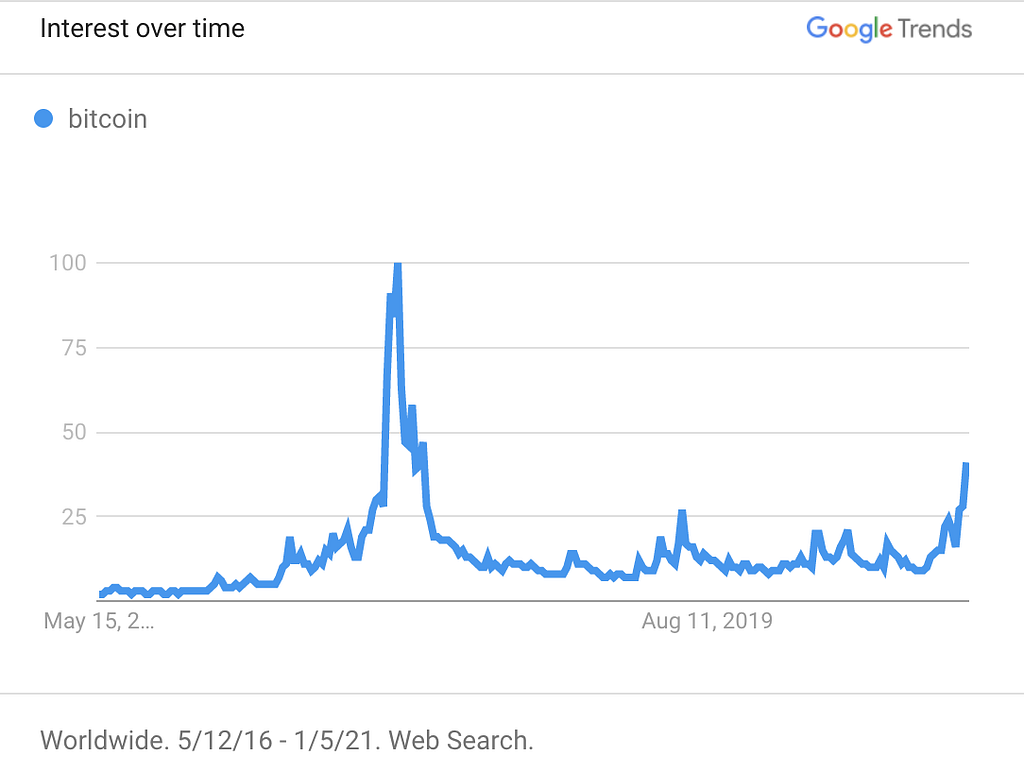
2. On-Chain Analysis
Each month we dive into on-chain data to explore interesting trends or movements on the Bitcoin network. (Table 2)
Table 2: Bitcoin network activity — December vs November

Strong network activity in December 2020
After an already high network activity in November, December has seen even higher metrics across the board (Table 2). The number of payments, estimated from the transaction outputs, are up 5.8%, and the number of active addresses up 4.5%.
Table 3: Bitcoin mining metrics — December vs November

The hash rate, an essential component for network security
Table 3 shows metrics related to mining activity. With the increase in price, the hash rate is on the rise (+5.8%), at an all time high estimated at 137 EH/s for the month of December. Interestingly, it has just beaten the rate of 136 EH/s seen for the month of September, despite the mining revenue increase by 27.5% in December and doubling since September. The hashing (computing) power involved in mining blocks is what makes the network resistant to attacks.
Back in June, we created a bitcoin security metric called the Market Value Adjusted Network Security (MVANS) indicator, which is the ratio of the market value and the estimated hash rate.
At a given market cap, the more hashing power the more secure the network is; and at a given hash rate, an increase in market makes the market more valuable and arguably more attractive to attacks.
In other words, the lower MVANS the ratio, the more secure the network is.
Figure 1 shows that the network has become less secure with the market value increasing faster than the hash rate. However, the network went through the previous bull run without attacks even though MVANS was at least 5 times higher.
Figure 1 : An increasing MVANS, even though the network is still relatively secure.

Figure 2 : MVRV reaching extreme level
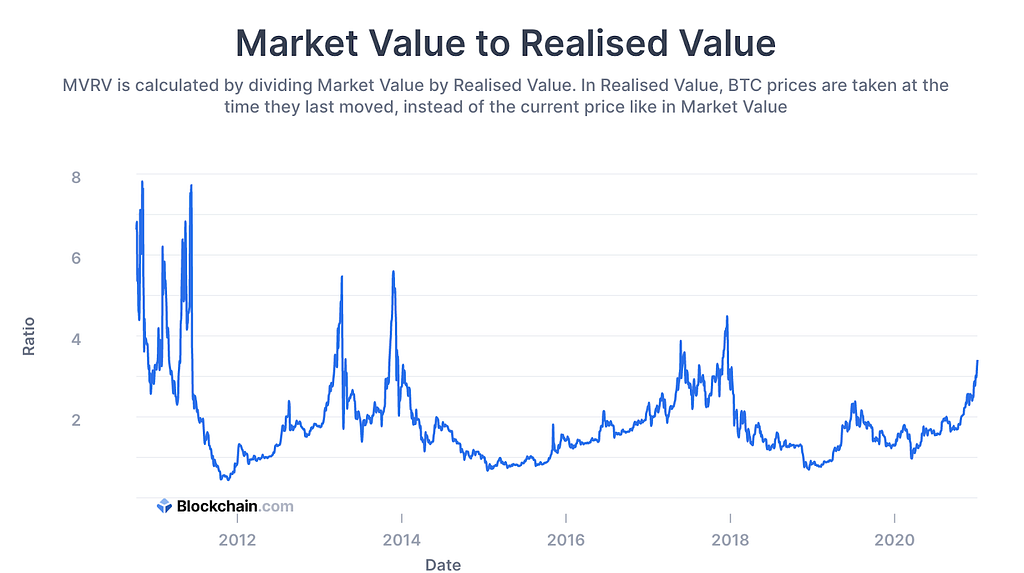
We have also observed that the Network Value to Realised Value (MVRV) ratio is approaching levels seen during the 2017 bull run. The network value, also known as the market cap, evaluates each bitcoin with the current price, whereas the realised value takes the price when it last moved. We are currently at a ratio of 3.5. At the top of the 2017 blowoff bull cycle the number was 4.5; a value that would put BTC at $45,000. However, as more and more BTC is bought by new entrants and moved off exchanges it will raise the denominator of this ratio, pushing the MVRV metric down.
In other words, if extremeness of sentiment is measured as the value of the asset class relative to its historic cost basis, we are definitely entering the extreme phase. However, current market dynamics are significantly different this time given the global economic crisis and various political developments.
3. Spotlight on Stellar (XLM): Guest Feature by Blue Alpine Research
Editor’s note: the Stellar Network token XLM has seen significant recent gains on the back of news of Ukraine selecting Stellar for testing a central bank digital currency, as well as greater regulatory clarity from the US OCC regarding the use of stablecoins and blockchains by banking institutions. Alongside this guest post on what’s new with Stellar please also see our XLM research primer published last year.
Stellar is an open-source blockchain technology which was created by the non-profit stellar.org. Its native token is the Lumen (XLM) and the main goals for Stellar are to bring banking to the unbanked, make remittances more cost-efficient and fast, offer the ability to make micropayments quickly as well as give the option for sending and receiving money from mobile devices.
The Stellar Network was founded in 2014. The Stellar Development Foundation (SDF) helps shepherd the network protocol and distribute XLM tokens.
Team and Advisors
There are currently nine people in the Stellar Leadership team. One of the co-founders, Jed McCaleb has a strong track record of creating successful products. He created eDonkey2000, one of the biggest peer-to-peer file sharing applications after 2000, as well as Mt. Gox which was the first Bitcoin exchange. Mt. Gox has had a controversial bankruptcy with stolen coins but McCaleb sold his share of the company before the problems happened. He then went on and created Ripple, another cryptocurrency which is currently in the top 4 of market capitalizations (June 2020).
The CTO of Stellar, Nicolas Barry, worked at Microsoft and Salesforce in technical roles before becoming the CTO of Stellar in September 2017. His main expertise is in distributed systems and software engineering.
Stellar’s Chief Scientist, David Mazières holds a Computer Science degree from Harvard and a PhD from MIT. He was a professor at Stanford University and his studies include distributed systems with a focus on security. He developed the Stellar Consensus Protocol together with Jed McCaleb.
Stellar’s advisory board is comprised of a number of noteworthy technologists, investors and entrepreneurs, including:
• Patrick Collison, CEO and co-founder of Stripe
• Matt Mullenweg, Creator of WordPress
• Greg Stein, Director at the Apache Foundation
• Naval Ravikant, Founder at Angellist
• Sam Altman, President of YCombinator
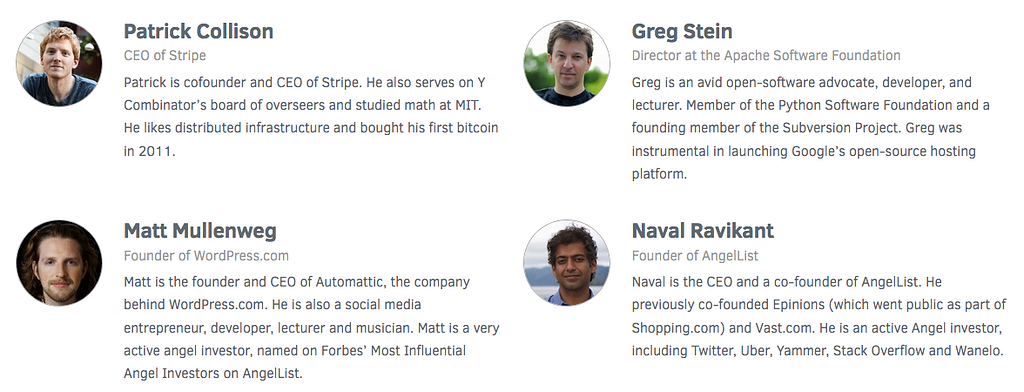
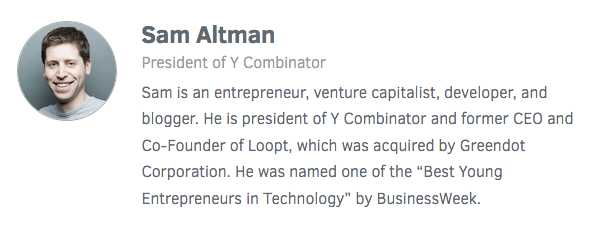
Stellar Foundation board members also include some well known names, such as Keith Rabois, investment partner at Khosla Ventures, Shivani Siroya, CEO of Tala (formerly InVenture; they provide financial reporting services to institutions in emerging markets), Greg Brockman, former CTO of Stripe and Joyce Kim, who is both a Stellar co-founder and founding member of Spark Labs, a VC company focused on blockchain technologies.
Technology and Products
The Stellar network consists of two main elements: Stellar Core and Horizon. While Horizon is a RESTful HTTP API Server, Stellar Core powers the connection to the Stellar network which is distributed across different individuals and organizations.
Using this structure, developers can build on top of these two services. Whether it is a mobile wallet, an online banking application or another custom app using the Stellar network, they have to connect first to the Horizon server which then in return connects to Stellar Core and the Stellar network.
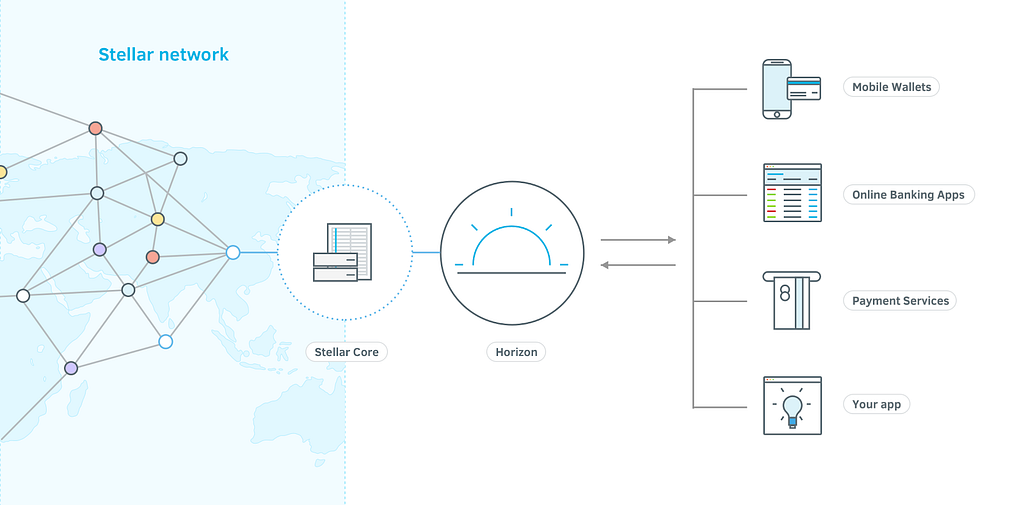
Anchors
Anchors in the Stellar network are entities that allow its users direct deposits into the Stellar network. They are the on and off ramps between the clients and the Stellar network.
Stellar Consensus Protocol (SCP)
The Stellar Consensus Protocol (SCP) is key element of the Stellar network and facilitates network transactions that have:
- low latency
- flexible trust
- asymptotic security
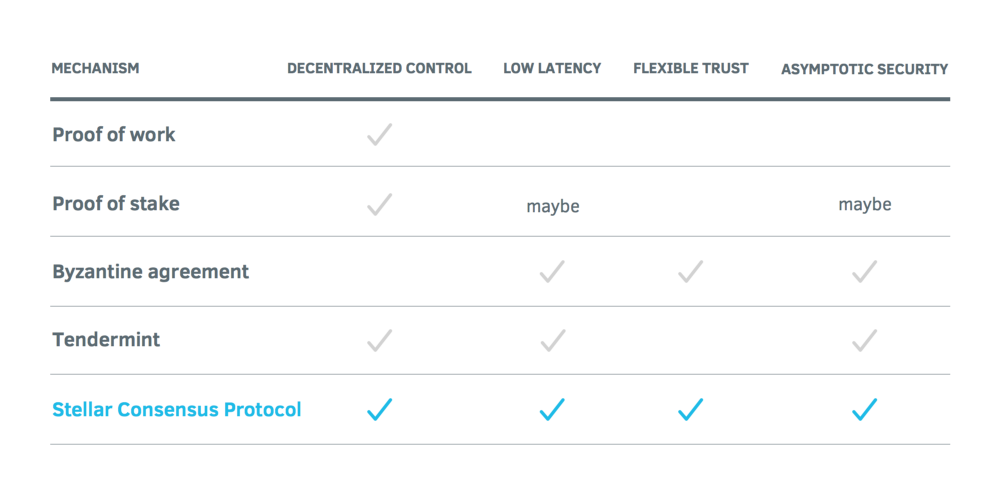
In order to describe how the SCP is working it is important to understand the concept of quorums and agreements. In a distributed system a quorum is a set of nodes that is sufficient to reach agreement. The Federated Byzantine agreement introduces the concept of a quorum slice, meaning a subset of nodes that have agreed with each other. When multiple quorum nodes share an agreement, it is called a quorum intersection (vs. a disjoint quorum when they don’t agree).
In order to explain quorums and agreements, this is the example that Stellar gives:
A group leader is trying to decide on a food to order for the entire company and gives two suggestions (A and B), without explicitly giving a vote. The rest of the group discusses the choices and then gradually accepts choice A. So the quorum, in this case the group, accepts choice A and a so-called v-blocking sets in, which blocks option B. At this stage, since there are no other possible voters, the quorum ratifies the choice and sets the accepted state to confirmed state (choice A).
The SCP wants to avoid getting stuck on voting decisions and that is why it introduces a so called ballot, giving the stuck parties options of a referendum. Each node (which in the above example is a group member) can either commit or abort the ballot. By aborting choice B, it opens up the possibility of choice A to continue.
Roadmap
Stellar has outlined three main goals for 2020:
- Support robustness and usability of Stellar by making it safe and easy to build on Stellar
- Be the blockchain People Know and Trust by establishing SDF on the global stage
- Foster and develop sustainable Stellar use-cases enabling cross-border payments and securitized assets.
StellarX — the Stellar Decentralized Exchange
Stellar presents StellarX as the front-end to the existing technology that they already have in place, allowing fiat on/off ramps as well as exchanging cryptocurrencies for free. They offer connecting directly to an existing Ledger Wallet or building a new one and provide peer-to-peer transactions without fees.
After the Mobius ICO, they are also offering MOBI tokens as a native token on the StellarX Dex.
Market data
At present, Stellar’s market capitalization is $1.3b USD with a circulating supply of 20,368,085,646 XLM (June 2020).
Both the trade volume and the market capitalization are healthy considering the general market sentiments. At the creation of Stellar 100 billion lumens were created including an annual increase of 1%.
After a community vote in October 2019, the total lumen amount was decreased to 50 billion lumens and won’t be increased anymore. Not all lumens have been distributed yet. Per the SDF mandate the split is as follows:
• Direct Development 12bn lumens
• Ecosystem Support 2bn lumens
• Use-case investment 10bn lumens
• User acquisition 6bn lumens
News and Partnerships
The two biggest partnerships from Stellar are IBM World Wire (an alternative to SWIFT and Ripple) as well as SatoshiPay, an effort to get into micropayments. However, SatoshiPay was struggling to get a Series A funding round due to the Corona crisis and got a loan of 550k USD in XLM tokens from the SDF.
There is no evidence that the banks will continue using Stellar, versus creating their own currencies, but due to the partnership with IBM the likelihood of using the Stellar infrastructure is given.
Ease of use & Availability
As of June 2020 Stellar Lumens are mainly available on Binance, Coinbase, HitBTC and OKex.
Transferring the bought coins is easy and fast.
Thanks to the Ledger Nano S support it is possible to store Lumens on a hardware wallet but also on a digital wallet such as the official one by Stellar.
A transfer of tokens currently takes less than a minute to confirm, making it one of the fastest cryptocurrencies in the market (June 2020).
There is a base fee of 100 stroops (0.00001 XLM) per transaction in order to avoid spam transactions and there is a possibility of this base fee per transaction to change.
4. What we’re reading, hearing and watching.
Crypto
- Alt-M: Has Bitcoin Succeeded?
- Bloomberg: Cryptocurrency Is Not Necessarily the Future
- Coin Metrics’ State of the Network: Issue 82 — The State Of The Network 2020 Year In Review
- CSIS Briefs: Central Bank Digital Currency, Design Choices, and Impacts on Currency Internationalization
- Defiance: The Bullish Case For Bitcoin
- Electric Capital: Electric Capital Developer Report (2020)
- Financial Times: Will bitcoin end the dollar’s reign?
- Real Clear Policy: Either the US Leads on Crypto, or China Will
- The Block: Stablecoin on-chain volumes have crossed the $1 trillion mark this year
- The Economist: Will central-bank digital currencies break the banking system?
- The Daily Gwei: #142 Compounding Confusion
Beyond Crypto
- Bloomberg: Companies Are Feeling California. Blame Bad Government.
- Bloomberg: Nigeria Orders Mobile Users to Link Phones to ID Numbers
- Financial Times: Apple Pay draws antitrust attention
- Project Syndicate: China Should Join the Paris Club
- The Economist: Wall Street’s latest shiny new thing: quantum computing
- The Information: Facebook’s Big Risk From Antitrust Suit Is Losing WhatsApp
- The Reformed Broker: The Goldmine
- The Telegraph: Senior staff at HSBC, Standard Chartered and Deutsche Bank are Chinese Communist Party members
- Wall Street Journal: A Reckoning Looms for Commercial Real Estate — and Its Lenders
- Wall Street Journal: Beijing’s Bid for Financial Supremacy
Footnotes:
- Average daily number of confirmed transactions in the public blockchain
- Average daily number of confirmed transactions sent from our Blockchain Wallet and API
- Average daily number of unique addresses used as inputs and outputs in the confirmed transactions
- Average daily number of estimated payments in the public blockchain
5. https://www.stellar.org/about/. Screenshot taken on on 2018–01–03.
6. https://www.stellar.org/developers/guides/get-started/index.html.
Screenshot taken on on 2018–01–04.
7. https://medium.com/a-stellar-journey/on-worldwide-consensus-
359e9eb3e949. Screenshot taken on on 2018–01–04.
8. Rust in Blockchain. Rib newsletter 11 — the flourishing spring. https://rustinblockchain.org/newsletters/2020–05–06-the-flourishing- spring/. Accessed on 2020–06–25.
9. SDF. 2020 stellar roadmap. https://www.stellar.org/roadmap. Accessed on 2020-06–24.
10. David Gobaud. Mobius — we did it! https://medium.com/mobius-network/
mobius-we-did-it-ae32826f2c2a. Accessed on 2018–01–28.
11. SDF. Ibm world wire. https://www.stellar.org/case-studies/ibm-world-
wire. Accessed on 2020–06–20.
12. Paddy Baker. Stellar throws satoshipay a $550k lifeline after coronavirus knocks out series a. https://www.coindesk.com/stellar-satoshipay-lifeline-coronavirus. Accessed on 2020–05–28.
13. Stellar. https://www.stellar.org/account-viewer/#!/. Accessed on 2020–05–30.
14. Stellar. https://developers.stellar.org/docs/glossary/fees/. Accessed on
2017–01–05.
Crypto: A $1 Trillion Asset Class was originally published in @blockchain on Medium, where people are continuing the conversation by highlighting and responding to this story.


